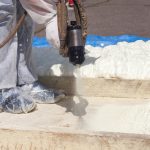Aerospace Foam: An Important Part of Aircraft Safety
There is no room for error in the aerospace industry, even when it comes to aerospace foam. This material is found in various areas of an aircraft, including flight deck pads, passenger cabin walls, ceilings, storage containers, class and section dividers, and elements of the lavatory.
Additionally, you can find water-based polyurethanes on aircraft exterior coating and acrylic-based polyurethane in window panes and exterior light coverings. But, what exactly does it do in these areas?
When an aircraft is in flight, it experiences numerous challenges. The exterior and interior are exposed to rapid and large changes in temperature, which is where aerospace foam comes in. The material has advanced temperature and insulating properties, allowing it to protect the aircraft and its passengers from temperature changes. It also helps prevent air leakage into or out of the aircraft, which preserves cabin pressure. Additionally, it provides a strong sound barrier, which protects passengers from the loud sounds of the aircraft. Now that we’ve covered what aerospace foam does, let’s dive into how it’s applied to the aircraft.
How is Aerospace Foam Applied?
Aerospace foam is applied using special equipment and mix heads. This includes high-pressure, low-pressure, gas nucleation, and spray equipment, along with L-style, straight-style, and spray-style mix heads. How does each of these products work? Here, we’ll explain each process and how they’re used to install aerospace foam.
Equipment
High-pressure, gas nucleation, spray, and low-pressure equipment are popular choices for installing aerospace foam.
High-pressure equipment delivers chemicals through heated hoses from supply tanks into a gun chamber. In the gun chamber, the two chemicals react with each other and are sprayed at elevated temperatures and pressures.
Low-pressure equipment is used to air seal and insulate small to midsize areas. During the spraying process, the chemicals combine in the nozzle chamber and are sprayed at room temperature at low pressure.
There are two types of gas nucleation equipment that can dramatically cut costs due to their efficiency.
- CO2 gas infusion blending units create a homogenous distribution and dissolution of CO2 into the polyol component of the polyurethane foam. This equipment reduces the amount of CO2 consumed, which reduces your chemical costs and provides part weight reduction, improved foam cellular structure, and improved acoustical and sound absorption properties.
- A dry air/N2 gas infusion blending unit improves wet ability, mixing quality, material flow, and eliminates surface defects. It’s best used to mold complex geometries and part configurations to prevent streaks and runs.
Spray equipment gets its chemical supply from drum pumps or heated day tanks, and is hydraulic-powered with automatic closed-loop control of mixing ratio and flow rate. It allows for high-pressure impingement mixing and features chemical pre-heaters and electrically heated hoses to control viscosity.
Mix Heads
L-style, straight-style, and spray-style mix heads are some of the best choices for applying aerospace foam; which one you choose will depend on the mixing equipment that’s best for your application.
L-style mix heads have two chambers that are perpendicular to each other. This is where the polyol and isocyanate chemicals combine (or counter-impinge) with each other. This mixture then goes into a larger chamber, where it is distributed based on your throughput and application requirements. L-style mix heads feature a unique angle that slows material velocity, resulting in an even discharge and laminar flow.
Straight-style mix heads don’t have an area for the chemicals to counter-impinge. Instead, the material flows lengthwise through the mix head and out via two to four streams. Straight-style mix heads feature multiple nose lengths that ensure you can reach the desired area for application. When the material is not being poured, the chemicals in the mixture are recirculated to maintain a proper ratio and temperature.
While L-style and straight-style mix heads mix chemicals and chambers and then distribute them into molds or via flows, spray-style mix heads are different. These mix heads distribute material directly, whether it be via a hand-held sprayer or robotic mount. These mix heads spray the polyurethane foam at high pressure directly onto a surface or part as the chemicals are delivered to the mix head via heated hoses that ensure the material performs as needed. Straight mix heads may be the most versatile, as they are available with circulating or non-circulating capability, and hydraulic, pneumatic, or manual actuation controls. At Linden Polyurethane, we also offer spray-style mix heads with ceramic mixing chambers that resist wear and tear.
Looking for Equipment to Apply Your Aerospace Foam? Work with Linden Polyurethane
At Linden Polyurethane, we’ve been providing polyurethane equipment for decades. Founded in 1985, we are a world-class designer, engineer, manufacturer, and service provider for standard and custom polyurethane machine processing machinery. This machinery includes polyurethane equipment as well as a wide variety of mix heads.
For decades, we’ve been successfully pioneering polyurethane innovations and refining tools and equipment used by countless industries through control integration, precision machining, and a relentless approach to continual improvement.
At present, we can design and manufacture all kinds of polyurethane metering, processing, distribution, and storage systems in-house, as well as provide service and repair for equipment manufactured by other organizations.
Let’s Discuss Your Polyurethane Equipment Needs
When you’re ready to acquire new polyurethane equipment or repair your existing gear, we’re ready to help. Reach out to one of our helpful team members here.





